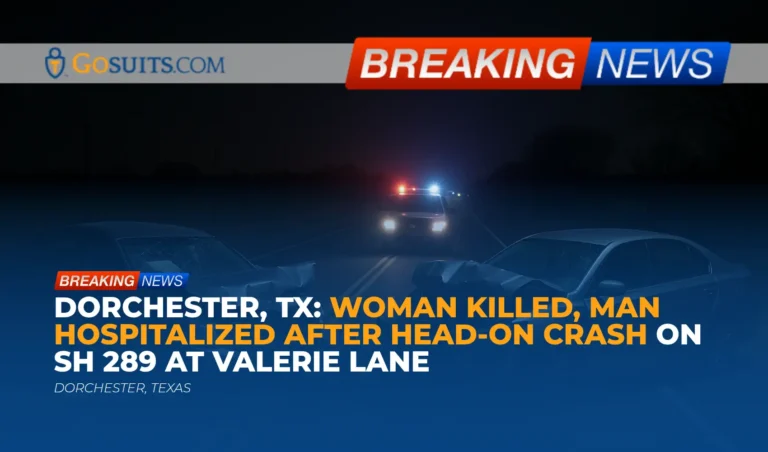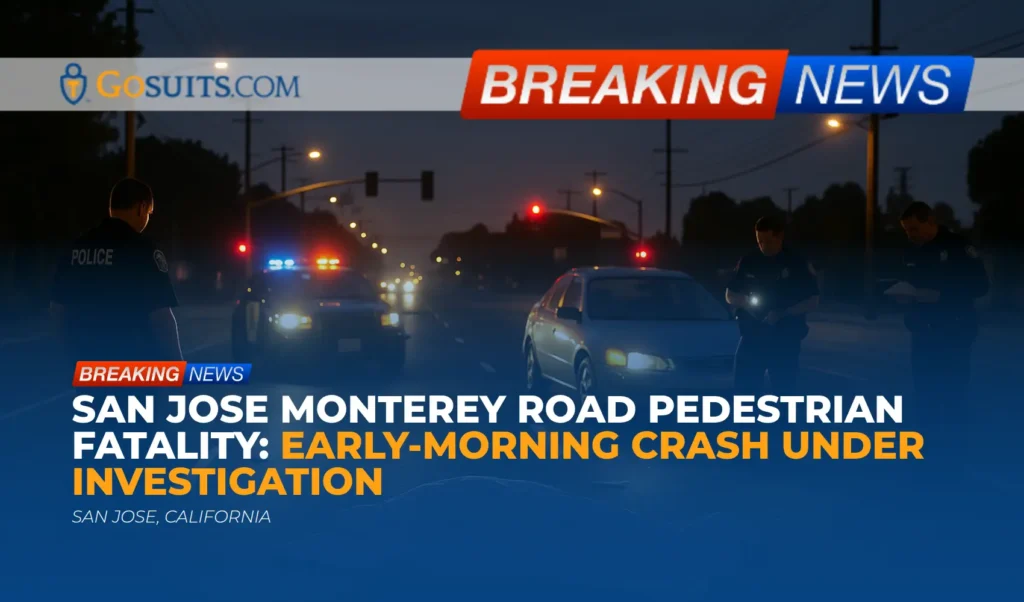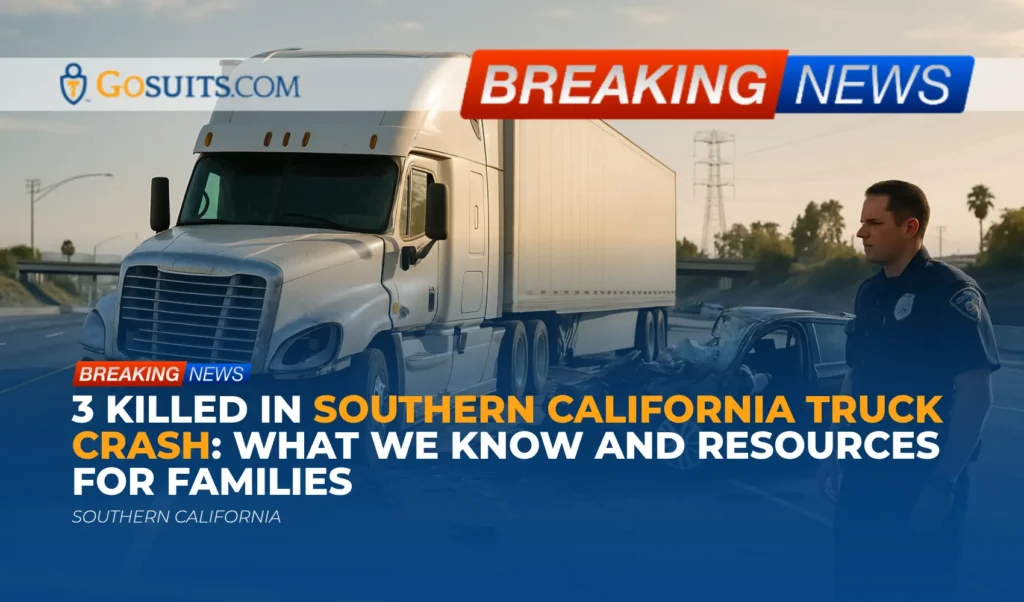- Overview of the reported Dorchester collision
- What we know so far and what remains under investigation
- How fatal crash investigations proceed in Texas
- Obtaining official records: crash report, death certificate, inquest or autopsy, 911 materials
- Grief and practical support resources
- Rights and potential civil claims after a fatal or serious crash in Texas
- Possible liability in head-on collisions: factors and evidence
- Insurance coverage issues that may apply
- Preserving evidence and meeting deadlines
- Safety context: why head-on crashes are so severe
- What community members can do now
- Commentary from Gosuits Dorchester, Texas Personal Injury Attorney
- Practical next steps and why timely action matters
Overview of the reported Dorchester collision
Reports indicate a head-on collision occurred in the early morning hours in Dorchester, Texas, near Southmayd. The crash was reported around 2 a.m. at the intersection of State Highway 289 and Valerie Lane. One driver, a woman, was pronounced deceased at the scene. The other driver, a man, was transported to a local hospital for treatment of injuries. Authorities closed Highway 289 for several hours and later reopened it. The names of those involved have not been publicly released at the time of reporting.
When serious or fatal collisions occur on Texas highways, multiple agencies may respond, including local law enforcement, county authorities, and state agencies. Early details are often limited while responders secure the scene, begin an investigation, notify next of kin, and compile official reports.
What we know so far and what remains under investigation
Known information
According to initial reporting:
- Crash type: Head-on collision involving two vehicles.
- Location: Intersection of SH 289 and Valerie Lane in Dorchester, near Southmayd in Grayson County.
- Time: Approximately 2 a.m. on a Sunday morning.
- Outcomes: One woman died at the scene. A male driver was hospitalized.
- Road closure: Highway 289 was closed for several hours and later reopened.
Information often unavailable initially
In the first hours and days after a serious crash, the following details are often not yet public:
- Cause and contributing factors: Speed, lane departure, impairment, fatigue, roadway conditions, or other factors typically require investigation.
- Vehicle specifics: Make, model, safety systems, and post-crash condition.
- Witness statements and 911 timeline: Obtained and reviewed by investigators before release.
- Official crash report: In Texas, peace officers file a formal report for injury or fatal crashes. This report is usually available after processing by the state’s crash records system.
Families often want prompt clarity. The reality is that thorough crash reconstruction takes time. It is appropriate for families to seek official records and independent guidance to understand what occurred.
How fatal crash investigations proceed in Texas
Texas law sets out clear procedures for investigating injury and fatal crashes. Peace officers who investigate crashes that cause injury or death are required to submit a written report to the Texas Department of Transportation. See Texas Transportation Code section 550.062. You can review the statute here: Texas Transportation Code 550.062.
In addition to the officer’s crash report, investigators may:
- Document the scene: Measurements, roadway evidence, tire marks, debris fields, signs, lighting, and weather conditions.
- Photograph and video record: Scene, vehicles, and injuries.
- Collect witness accounts: Interviews with drivers, passengers, and bystanders.
- Download vehicle data: Many vehicles record pre-crash speed, braking, throttle, and seatbelt status via event data recorders. Federal regulations describe EDR data elements in 49 CFR part 563, available here: 49 CFR Part 563.
- Order toxicology: Toxicology testing in fatal crashes is typical and is governed by Texas inquest procedures. See Texas Code of Criminal Procedure chapter 49: Tex. Code Crim. Proc. ch. 49.
If a death occurs, Texas law requires an inquest by a Justice of the Peace or a Medical Examiner, depending on the county. The inquest includes determining cause and manner of death and whether an autopsy is needed. See the inquest process in the Code of Criminal Procedure chapter 49 linked above.
Obtaining official records: crash report, death certificate, inquest or autopsy, 911 materials
When families are coping with sudden loss, clear information can help them make decisions about medical care, funeral arrangements, and potential civil claims. The following official records are commonly available in Texas.
Crash report (CR-3)
For crashes involving injury or death, the investigating officer files a CR-3 crash report with the state. Eligible parties can purchase the report through the Texas Department of Transportation’s Crash Records Information System. See TxDOT’s guidance here: TxDOT Crash Reports and Records.
The crash report generally includes diagrams, contributing factors noted by the officer, insurance information listed at the scene, and sometimes statements. It is not unusual for the report to take days or weeks before it becomes available.
Death certificate
A certified death certificate is issued by the State of Texas through the Department of State Health Services Vital Statistics Section. Information and ordering options are here: Texas DSHS Vital Statistics — Death Records. Funeral homes often assist families with this process.
Inquest and autopsy records
In Texas, the Justice of the Peace or county Medical Examiner conducts an inquest into unattended or sudden deaths, including those arising from motor vehicle crashes. Records from the inquest, including whether an autopsy was performed and any toxicology results, are retained by the presiding office. The governing law is in the Code of Criminal Procedure chapter 49: Tex. Code Crim. Proc. ch. 49.
Procedures vary by county. Some counties have Medical Examiner offices that process records requests directly. Counties without a Medical Examiner typically route requests through the Justice of the Peace who handled the inquest.
911 audio, dispatch logs, body camera footage, and scene photographs
Many incident-related records are subject to the Texas Public Information Act. Members of the public can request certain records from the responding agency, subject to legal exceptions for confidentiality or ongoing investigations. The Texas Attorney General provides guidance for the public on open records here: Texas Public Information Act — Members of the Public.
Hospital records and EMS reports
Medical records for an injured person can be requested from the hospital and EMS agency by the patient or their personal representative. Release typically requires written authorization under state and federal privacy laws.
Vehicle release and storage
Vehicles are often towed from fatal crash scenes for safekeeping and investigation. The tow yard information is usually listed on the incident report. It is important to coordinate any vehicle release with investigators and insurance, and to consider preserving the vehicle for inspection if a civil claim may be pursued.
Grief and practical support resources
The sudden loss of a loved one is devastating. Support can be both emotional and practical. National and state resources include:
- 988 Suicide and Crisis Lifeline: Dial 988 for 24-hour emotional support sponsored by the U.S. Department of Health and Human Services. Information here: CDC information on 988.
- CDC guidance on grief: Educational resources on bereavement and coping after traumatic loss: CDC — Grief and Loss.
Community-based organizations, faith groups, and victim-services programs in the region may also assist with counseling referrals, crime-victim compensation information, and practical needs.

Rights and potential civil claims after a fatal or serious crash in Texas
Texas law provides civil remedies when a person is injured or killed due to another’s wrongful act, neglect, carelessness, unskillfulness, or default. Two complementary types of claims are common: wrongful death claims on behalf of certain relatives, and survival claims on behalf of the deceased person’s estate.
Wrongful death
The Texas Wrongful Death Act allows a surviving spouse, children, and parents to bring a claim for losses they personally suffer due to a loved one’s death. See Texas Civil Practice and Remedies Code chapter 71, including sections 71.002 and 71.004: Tex. Civ. Prac. & Rem. Code ch. 71. Categories of recoverable losses may include mental anguish, loss of companionship and society, and loss of financial contributions, subject to proof and Texas law.
Survival claim
A survival claim allows the deceased person’s own cause of action to continue after death for harms such as pain, mental anguish, and medical expenses incurred before passing. This claim is brought by the estate’s legal representative. See Tex. Civ. Prac. & Rem. Code 71.021.
Time limits
Most Texas wrongful death and personal injury claims must be filed within two years. See Texas Civil Practice and Remedies Code section 16.003: Tex. Civ. Prac. & Rem. Code 16.003. There are important exceptions and nuances, so early attention to deadlines matters.
Comparative responsibility
Texas follows a proportionate responsibility system. If more than one party is at fault, each may be assigned a percentage of responsibility. A claimant who is more than 50 percent responsible is generally barred from recovery. See Texas Civil Practice and Remedies Code chapter 33: Tex. Civ. Prac. & Rem. Code ch. 33.
Possible liability in head-on collisions: factors and evidence
Even when initial details are limited, there are recurring issues in head-on collisions that investigators and civil practitioners examine to assess responsibility. Each case turns on its facts, but common considerations include:
- Lane departure: Which vehicle crossed the centerline or median, and why. Evidence includes roadway markings, gouge marks, and vehicle crush patterns.
- Speed and visibility: Nighttime crashes at 2 a.m. raise questions about lighting, headlight use, and appropriate speed for conditions.
- Impairment or fatigue: Toxicology and witness accounts can be important. Results are typically handled through the inquest process described in Texas law.
- Roadway design and maintenance: Curve geometry, signage, shoulder condition, and lane markings can contribute. Safety concerns can be reported to the Texas Department of Transportation.
- Vehicle condition and restraints: Tire integrity, steering components, and whether seatbelts were in use can affect both fault and injury severity.
- Distraction: Potential mobile device use can be investigated through phone records and vehicle systems in some circumstances.
Civil liability may involve one or more drivers and, in some cases, entities responsible for the roadway if hazardous conditions are proven. Thorough evidence preservation is essential to understand what happened and to fairly assign responsibility.
Insurance coverage issues that may apply
Motor vehicle insurance often determines what funds are available for medical bills, funeral expenses, lost income, and other legally recoverable losses. Key coverage types in Texas include:
- Liability coverage: Texas requires drivers to maintain financial responsibility for injuries and damages they cause. Minimum limits are set by statute. See Texas Transportation Code section 601.072: Tex. Transp. Code 601.072.
- Uninsured or underinsured motorist (UM/UIM): May apply if the at-fault driver has no insurance or too little, subject to policy terms.
- Personal injury protection (PIP) and Medical Payments (MedPay): May provide limited no-fault benefits for medical and certain related expenses, depending on the policy and state requirements.
- Wrongful death and survival damages: Paid, if proven, through applicable liability coverage or other sources as allowed by law.
Insurance companies commonly request recorded statements and authorizations. It is prudent to speak with a qualified attorney before communicating with any insurer about the facts of the crash. What is shared with an insurance adjuster can be used later in ways that affect a claim.
Preserving evidence and meeting deadlines
After a serious crash, crucial evidence can be lost quickly. Steps that often help preserve the truth include:
- Prompt crash report request: Monitor availability of the CR-3 report through TxDOT’s Crash Records Information System: TxDOT Crash Reports and Records.
- Vehicle preservation: Avoid authorizing repairs or disposal until inspection by appropriate experts. EDR data and mechanical components may be vital.
- Scene documentation: Photographs of the intersection, lighting, signage, and any roadway defects can be invaluable if conditions change.
- Open records requests: Consider timely requests for 911 audio, dispatch logs, and body camera video under the Texas Public Information Act: Open Government guidance.
- Medical documentation: Keep copies of treatment records, bills, and physician notes for any injured person.
- Estate documents: For survival claims, the estate’s representative may need to be appointed through the probate court before pursuing certain records or claims.
Legal deadlines can be strict. The general two-year statute for injury and wrongful death claims appears in Tex. Civ. Prac. & Rem. Code 16.003. Some claims against governmental entities involve additional notice requirements and shorter timelines. Acting promptly helps protect all options.
Safety context: why head-on crashes are so severe
Head-on collisions are disproportionately deadly compared to many other crash types because the closing speeds combine, producing high force at impact. Federal safety researchers have repeatedly noted the elevated risk of fatal injury in frontal collisions and the importance of lane discipline, speed management, and roadway design in preventing them.
For general national context:
- NHTSA Traffic Safety Facts provides data on crash types and outcomes, including the severity of frontal impacts: NHTSA CrashStats portal.
- CDC Transportation Safety offers educational material on preventing motor vehicle injuries: CDC Transportation Safety.
- Texas roadway safety: The Texas Department of Transportation’s public safety initiatives emphasize consistent daily traffic fatalities across the state since 2000. See TxDOT safety information here: TxDOT Safety.
This context does not determine what happened in any one crash. It underscores the importance of careful investigation, attention to roadway conditions, and driver behavior analysis when assessing a head-on collision.
What community members can do now
In the wake of a serious crash, communities often look for ways to show care and help reduce the risk of future harm. Constructive steps include:
- Respect privacy and process: Allow time for next-of-kin notifications and official inquiries before sharing unverified details.
- Share safe driving reminders: Encourage nighttime caution, seatbelt use, distraction-free driving, and appropriate speeds on rural highways.
- Report roadway concerns: Lighting outages, missing signs, or pavement markings can be reported to the Texas Department of Transportation district office serving the area.
- Offer practical support: Meals, childcare, and transportation can make a difference for those affected by sudden loss or injury.
Commentary from Gosuits Dorchester, Texas Personal Injury Attorney
Our thoughts are with everyone affected by the collision near Highway 289 and Valerie Lane. Losing a loved one without warning is heartbreaking, and injuries from a violent head-on crash can change a life in an instant. This article is intended to provide general information to help the public understand common next steps after a serious Texas crash.
Based on the early information, investigators will likely focus on lane position, speed for conditions, visibility at the intersection, and any signs of impairment or distraction. Head-on collisions almost always involve a deviation from the intended lane, so tire marks, debris patterns, and vehicle crush profiles become essential. We also expect that the inquest process will address cause and manner of death, which can be important for both closure and any future civil proceedings.
Insurance carriers and large corporate stakeholders tend to act quickly after severe crashes. Adjusters may request recorded statements or broad medical authorizations before families have a clear picture of what happened. It is not uncommon for early offers to arrive before the investigation is complete. This can put those affected at a disadvantage because critical facts, long-term medical needs, and legal rights may not yet be fully understood. Consulting with a seasoned personal injury attorney before speaking with insurers helps people understand their options and the potential consequences of statements that can be used later.
A free consultation provides an opportunity to ask questions in a confidential setting, learn about the investigative process, discuss insurance coverages that may apply, and consider ways to preserve evidence. It also helps individuals understand timelines and what documentation will be needed if they decide to move forward with a claim.

Practical next steps and why timely action matters
The period after a serious crash is overwhelming. Clear, practical steps can reduce confusion and protect important rights and information. The following actions are commonly helpful in Texas cases involving injury or loss of life:
- Identify the investigating agency: Determine whether the scene was handled by a local police department, county sheriff, or state troopers. This guides where to request 911 records and body camera footage, subject to the Public Information Act.
- Track the official crash report: Monitor the TxDOT Crash Records Information System for the CR-3 report and supplements: TxDOT Crash Reports and Records.
- Request vital records appropriately: Use Texas DSHS Vital Statistics for certified death certificates and contact the county’s Justice of the Peace or Medical Examiner for inquest or autopsy-related records, as allowed by law.
- Preserve the vehicles: Arrange secure storage and avoid repairs or disposal until the vehicles can be inspected and any event data recorder downloads are completed.
- Collect medical and funeral documentation: Maintain organized records of medical treatment, transport bills, and funeral expenses. These documents are often needed to evaluate insurance coverage.
- Document the scene conditions: If safe and feasible, photograph the intersection, signage, lighting, and pavement markings, recognizing that roadway conditions can change rapidly after a crash.
- Be cautious with insurance communications: Consider speaking with an attorney before giving any recorded statement or signing authorizations. Statements to insurers can be used later and may affect claim outcomes.
- Consider early legal consultation: A no-cost consultation can clarify deadlines, preserve evidence, and map out a plan for dealing with multiple insurers and potential claims, without any commitment to file.
Why acting sooner helps
- Evidence can disappear: Skid marks fade, vehicles get repaired, and electronic data may be overwritten. Early preservation protects the factual record.
- Deadlines apply: Texas civil claims have strict limitation periods and, in some situations, special notice requirements. Understanding these timelines early helps avoid accidental forfeiture of rights. See Tex. Civ. Prac. & Rem. Code 16.003.
- Insurance moves quickly: Carriers often start adjusting within days. Knowing what to say and what not to say matters because it may be referenced later.
- Financial planning: Hospital billing, funeral expenses, and lost income issues arise immediately. Timely information assists with short-term decisions while the investigation continues.
The most important thing is ensuring safety, care, and support for those directly affected. Information and thoughtful steps taken early can make the process more manageable as facts come into focus.
Additional legal context and reference materials
For readers who want to learn more about the Texas laws and public resources mentioned above, here are direct links to authoritative sources:
- Officer crash report requirement: Texas Transportation Code 550.062
- Crash report access: TxDOT Crash Reports and Records
- Wrongful death and survival claims: Tex. Civ. Prac. & Rem. Code ch. 71
- Two-year limitations period: Tex. Civ. Prac. & Rem. Code 16.003
- Proportionate responsibility: Tex. Civ. Prac. & Rem. Code ch. 33
- Financial responsibility minimums: Tex. Transp. Code 601.072
- Inquest and autopsy law: Tex. Code Crim. Proc. ch. 49
- Vital records: Texas DSHS — Death Records
- Public Information Act: Texas Attorney General — Open Government
- NHTSA crash research: NHTSA CrashStats
- CDC transportation safety: CDC Transportation Safety
- EDR rule: 49 CFR Part 563
These resources are general in nature and may be updated by the state or federal agencies that maintain them.






